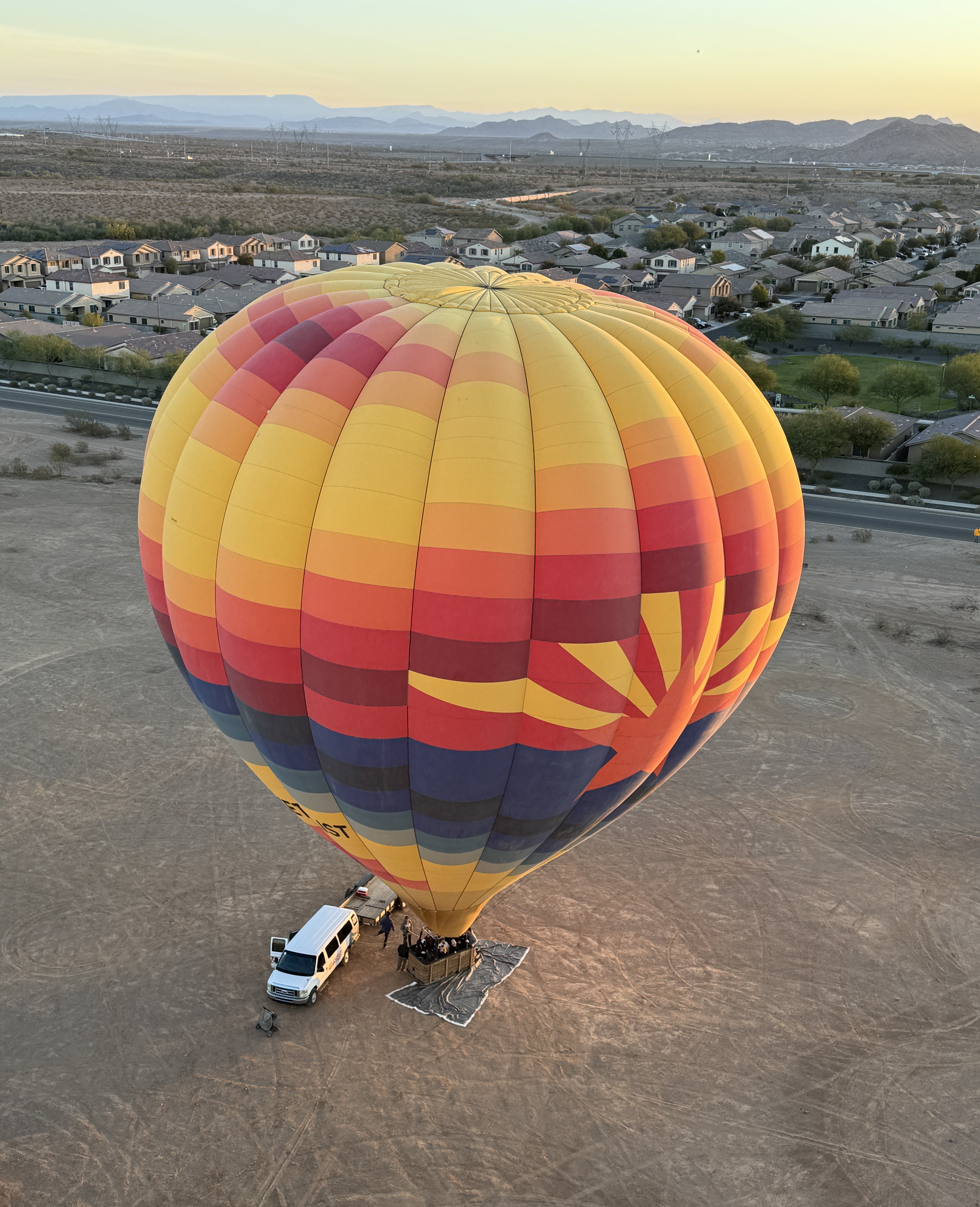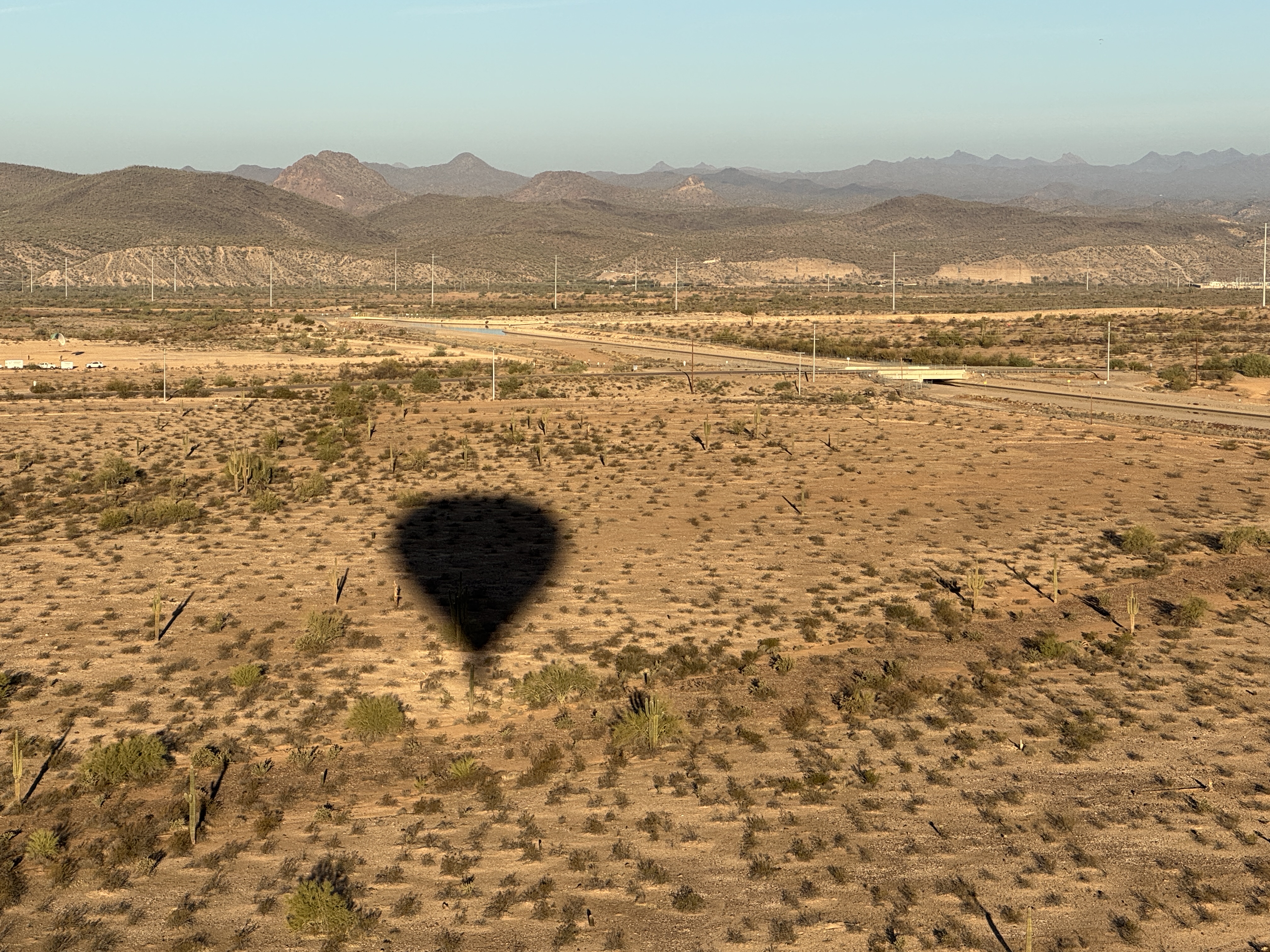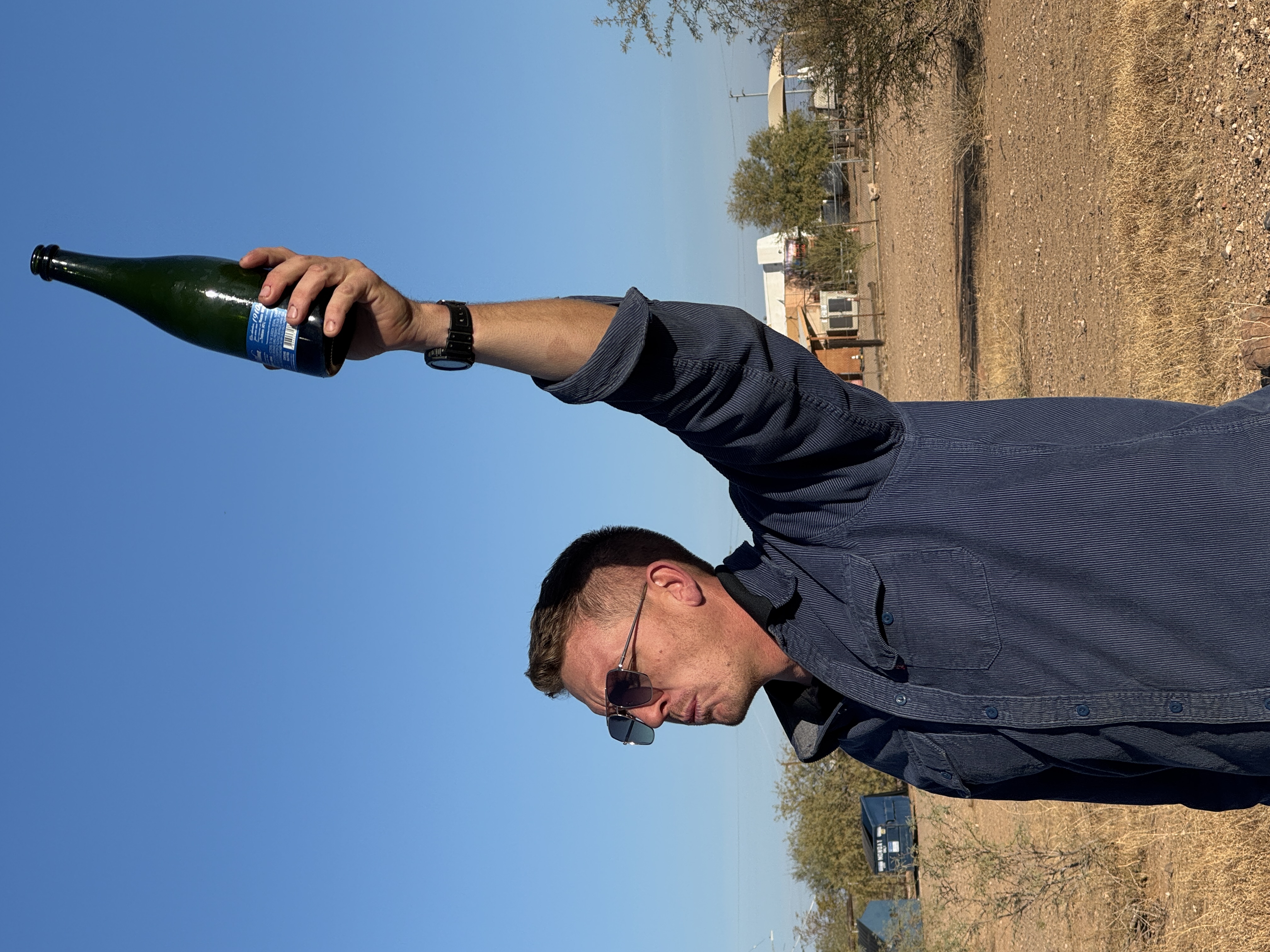From my perch in the sky, the view over the Sonoran Desert was sublime. It’s one thing to explore this landscape on foot; it’s another to experience if from a bird’s eye perspective high above the ground. Only then, are the wonders of this scenery fully realized and appreciated. I was on a sunrise hot air balloon flight with Rainbow Ryders in the Phoenix/Scottsdale area. It was a no brainer to choose this particular company, as I had done a previous flight with them in Albuquerque several years ago. And the experience had been magical and memorable.
I was on a sunrise hot air balloon flight with Rainbow Ryders in the Phoenix/Scottsdale area. It was a no brainer to choose this particular company, as I had done a previous flight with them in Albuquerque several years ago. And the experience had been magical and memorable. Founded in 1983, Rainbow Ryders has a stellar reputation in the industry. The award-winning company takes pride in offering the best bucket list experiences in Phoenix/Scottsdale, Albuquerque and Colorado Springs with its fleet of forty balloons. It places safety at the top of its core values and has an impeccable safety record. And it is a leader in driving new regulations to improve overall safety in the industry.
Founded in 1983, Rainbow Ryders has a stellar reputation in the industry. The award-winning company takes pride in offering the best bucket list experiences in Phoenix/Scottsdale, Albuquerque and Colorado Springs with its fleet of forty balloons. It places safety at the top of its core values and has an impeccable safety record. And it is a leader in driving new regulations to improve overall safety in the industry. Hot air ballooning has a long history with the first manned flight taking place in 1783 when brothers Joseph-Michael and Jacques-Etienne Montgolfier launched their balloon in France. The brothers had developed lighter-than-air devices that could stay in the air, finding that the air heating method was a simple way to propel upwards.
Hot air ballooning has a long history with the first manned flight taking place in 1783 when brothers Joseph-Michael and Jacques-Etienne Montgolfier launched their balloon in France. The brothers had developed lighter-than-air devices that could stay in the air, finding that the air heating method was a simple way to propel upwards.
After testing flights using unmanned balloons, then with animals, they eventually had two friends board the balloon in Paris. It rose 500 feet and flew about 25 minutes, landing in a vineyard. The feat was an instant sensation and met with awe and astonishment. Balloons back then were different from the ones that became popularized in the 20th century and are still used today. These employ propane gas and offer a much safer and more efficient method of staying in the sky longer, while providing more control over the balloon.
Balloons back then were different from the ones that became popularized in the 20th century and are still used today. These employ propane gas and offer a much safer and more efficient method of staying in the sky longer, while providing more control over the balloon.
This type of balloon was invented in the 1960s by Ed Yost, who launched his first flight in Nebraska in 1960. A few years later, he crossed the English Channel with this advanced design. And in 1987, Richard Branson and per Lindstrand accomplished the first ever Transatlantic flight in a hot air balloon, traveling 3,000 miles in just over thirty hours, proving the legitimacy of this type of transportation. Our flight began early in the morning with transport to the launch site. Then we watched the crews inflate the balloons via motorized fans. It’s fun to observe this process, as the brilliantly-hued “envelope” (the balloon’s fabric) fills with air and then the propane burners are ignited to heat the air inside. Meanwhile, the sun starts to rise, painting the sky fiery orange.
Our flight began early in the morning with transport to the launch site. Then we watched the crews inflate the balloons via motorized fans. It’s fun to observe this process, as the brilliantly-hued “envelope” (the balloon’s fabric) fills with air and then the propane burners are ignited to heat the air inside. Meanwhile, the sun starts to rise, painting the sky fiery orange. In thirty minutes or so, the balloon is ready for flight. But before taking off, you’ll learn how to get in and out of the balloon’s wicker basket using feet first. Don’t worry about being graceful! Later, you’ll also learn the all-important position for landing.
In thirty minutes or so, the balloon is ready for flight. But before taking off, you’ll learn how to get in and out of the balloon’s wicker basket using feet first. Don’t worry about being graceful! Later, you’ll also learn the all-important position for landing. The basket I was in held sixteen people plus the pilot. Each of the compartments fit four passengers. The pilot has his own spot in the middle, where he operates the burners. Know that you will be standing for the duration of the flight.
The basket I was in held sixteen people plus the pilot. Each of the compartments fit four passengers. The pilot has his own spot in the middle, where he operates the burners. Know that you will be standing for the duration of the flight. After launching, you’ll float gradually upwards. It’s amazing how light the balloon feels as it gently travels through the air. Unobstructed 360-degree vistas emerge, while your pilot explores a variety of altitudes using the burners to heat the air and the vents to release it. This allows him/her to ascend or descend into different “wind layers.”
After launching, you’ll float gradually upwards. It’s amazing how light the balloon feels as it gently travels through the air. Unobstructed 360-degree vistas emerge, while your pilot explores a variety of altitudes using the burners to heat the air and the vents to release it. This allows him/her to ascend or descend into different “wind layers.” At lower altitudes, our pilot Kyle pointed out some plant life below, including the impressive saguaro, an icon of the Sonoran Desert region. This plant is the largest cactus in the U.S. and can grow as tall as fifty feet. And its root systems can extend as far as a hundred feet.
At lower altitudes, our pilot Kyle pointed out some plant life below, including the impressive saguaro, an icon of the Sonoran Desert region. This plant is the largest cactus in the U.S. and can grow as tall as fifty feet. And its root systems can extend as far as a hundred feet.
The saguaro has longevity and can live up to two hundred years. Some develop upturned arms, while others remain limb free. These cacti are scattered across the landscape and appear as stalwart sentinels. At higher elevations, we had a marvelous overview of the valley and the surrounding White Tank Mountain Range, as well as Lake Pleasant, a large recreation area. You could also see the multitude of housing developments sprawling across the valley floor. Kyle told us that Maricopa County, which includes Phoenix and Scottsdale, along with 25 plus other towns and cities, is the fourth most populous county in the U.S. It covers nearly 10,000 square miles and is larger than Connecticut, Delaware and Rhode Island combined.
At higher elevations, we had a marvelous overview of the valley and the surrounding White Tank Mountain Range, as well as Lake Pleasant, a large recreation area. You could also see the multitude of housing developments sprawling across the valley floor. Kyle told us that Maricopa County, which includes Phoenix and Scottsdale, along with 25 plus other towns and cities, is the fourth most populous county in the U.S. It covers nearly 10,000 square miles and is larger than Connecticut, Delaware and Rhode Island combined. Another interesting sight was the system of canals that seem to stretch for miles, bringing drinking water to the surrounding locales.
Another interesting sight was the system of canals that seem to stretch for miles, bringing drinking water to the surrounding locales. While we floated effortlessly, Kyle regaled us with some fun stories about the proposals he has witnessed aboard the balloon. Most ended positively with a resounding “yes!” However, he has seen a few that unfortunately concluded with a “no,” making the rest of the balloon trip cringingly uncomfortable, especially if the proposal occurred early on in the ride.
While we floated effortlessly, Kyle regaled us with some fun stories about the proposals he has witnessed aboard the balloon. Most ended positively with a resounding “yes!” However, he has seen a few that unfortunately concluded with a “no,” making the rest of the balloon trip cringingly uncomfortable, especially if the proposal occurred early on in the ride.
And then there was the guy who let the ring slip from his fingers, falling out of the balloon. The woman he was proposing to lit into him with a vengeance until he pulled out the real ring and then it was all good. Kyle said it was a gutsy move for the guy and he took a lot of heat from it, but it made for a dramatic flight! As for our ride’s stats, we topped out at 7,000 feet, went a total of ten miles at a max speed of 33 mph. The journey was smooth and calm, and felt effortless. You’d be surprised at how peaceful it is the higher you ascend, as the only sounds you hear are the burners and the whooshing of air.
As for our ride’s stats, we topped out at 7,000 feet, went a total of ten miles at a max speed of 33 mph. The journey was smooth and calm, and felt effortless. You’d be surprised at how peaceful it is the higher you ascend, as the only sounds you hear are the burners and the whooshing of air.
To prepare for landing, we crouched down, held on to two handles and leaned to the right, while Kyle competently brought the balloon down with barely a bump. The crew was right there to help take down the balloon, as they also serve as “chasers,” who follow the balloon’s path during its flight. Once on terra firma, we celebrated with a traditional toast of champagne, as Kyle recited, “The Balloonist’s Prayer.” This custom got started in the early years of ballooning as a result of spectators’ reactions upon seeing a large object descend from the sky. They would get angry or afraid and attack the balloonists with pitchforks, thus destroying their balloons and chasing off the balloonists. Subsequently, balloonists opted to carry champagne on their flights and offer a toast to spectators to put them at ease.
Once on terra firma, we celebrated with a traditional toast of champagne, as Kyle recited, “The Balloonist’s Prayer.” This custom got started in the early years of ballooning as a result of spectators’ reactions upon seeing a large object descend from the sky. They would get angry or afraid and attack the balloonists with pitchforks, thus destroying their balloons and chasing off the balloonists. Subsequently, balloonists opted to carry champagne on their flights and offer a toast to spectators to put them at ease. “The winds have welcomed you with softness. The sun has blessed you with its warm hands. We have flown so high and so well that God has joined you in laughter and set you gently back into the loving arms of Mother Earth.”
“The winds have welcomed you with softness. The sun has blessed you with its warm hands. We have flown so high and so well that God has joined you in laughter and set you gently back into the loving arms of Mother Earth.”
www.rainbowryders.com/locations/phoenix/




















